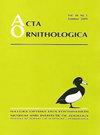当毒性不够时:伯劳捕食水泡甲虫(鞘翅目,花蛾科)的回顾和新资料
IF 0.8
4区 生物学
Q3 ORNITHOLOGY
引用次数: 0
摘要
摘要Lanius属的Shrikes在饮食方面是多面手,甚至食用剧毒物种,如水泡甲虫(鞘翅目,蜜瓜科)。尽管在最近和历史文献中从未描述过对这些鞘翅目昆虫的定期捕食,但鸟类是最常捕食这些昆虫的群体之一。在旧世界,自19世纪以来,就有关于伯劳捕食油甲虫的记录——其中大多数被视为轶事。然而,尽管是重复的,但尚未对这种行为进行审查或深入研究。经过文献研究和在伊比利亚半岛收集的新数据,这似乎是该分支内的一种扩展行为。正如在大量情况下可以观察到的那样,鸟类甚至应用了一种特定的技术,选择特定的身体部位来杀死甲虫,这种甲虫更具硬化性,可能毒性更小。在某些情况下,已经证明存在严格的捕食行为。到目前为止,至少有六种不同的伯劳——红背伯劳、大灰伯劳、伊比利亚灰伯劳(Iberian Grey shrike L.meridionalis)、Loggerhead shrike L.ludovicianus、小灰伯劳和Woodchat shrike L senator——在整个欧洲、北非和北美都显示出捕食至少九种蜜瓜科物种的迹象,构成了一条应该更详细研究的研究路线。本文章由计算机程序翻译,如有差异,请以英文原文为准。
When Toxicity is Not Enough: Review and New Data on Blister Beetle (Coleoptera, Meloidae) Predation by Shrikes
Abstract. Shrikes from the genus Lanius are generalists in terms of diet, even consuming highly toxic species, as blister beetles (Coleoptera, Meloidae). Despite the fact that regular predation on these coleopterans have never been described both in recent and historical literature, birds stand out as one of the groups to most often prey upon these insects. In the Old World, records of shrikes preying on oil-beetles — most of them treated as anecdotal — have been published since the 19th century. However, despite being repetitive, no review or in-depth study of this behavior has been conducted. After a literature study and new data collected in the Iberian Peninsula, it seems an extended behaviour within the clade. As could be observed in a high number of cases, birds even apply a specific technique, selecting specific body parts to kill the beetle, more sclerotic and presumably less toxic. In some cases, strict predation has been demonstrated. To date, at least six different shrike species — Red-backed Shrike Lanius collurio, Great Grey Shrike L. excubitor, Iberian Grey Shrike L. meridionalis, Loggerhead Shrike L. ludovicianus, Lesser Grey Shrike L. minor, and Woodchat Shrike L. senator — have been found to show signs of preying on at least nine Meloidae species throughout Europe, North Africa and North America, constituting a line of research that should be studied in greater detail.
求助全文
通过发布文献求助,成功后即可免费获取论文全文。
去求助
来源期刊

Acta Ornithologica
生物-鸟类学
CiteScore
2.10
自引率
0.00%
发文量
14
审稿时长
>12 weeks
期刊介绍:
Publishes scientific papers (original research reports, reviews, short notes, etc.) and announcements from all fields of ornithology. All manuscripts are peer-reviewed.
Established in 1933 as Acta Ornithologica Musei Zoologici Polonici, since 1953 continued under the present title.
Published twice a year by the Natura Optima Dux Foundation under the auspices of the Museum and Institute of Zoology, Polish Academy of Sciences.
 求助内容:
求助内容: 应助结果提醒方式:
应助结果提醒方式:


